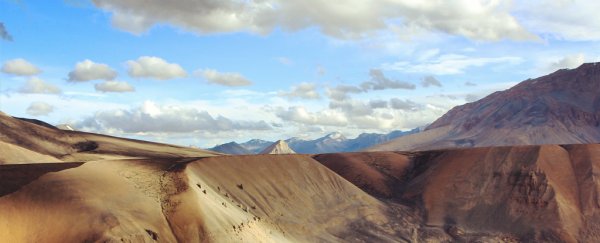It's a process that can take billions of years, but mountains do indeed grow – and exactly what factors control that growth has been the subject of an ongoing debate between scientists. Now it looks as though we may finally have a definitive answer.
According to a new study, tectonic forces underneath mountains - rather than any weathering and erosion on top - control how big they can grow. Thus, for mountains near tectonic plate collision zones, maximum mountain height is mainly determined by an equilibrium of forces deep in Earth's crust.
As tectonic plates move and shift towards each other, one of the plates is forced downwards into Earth's mantle; as the plates buckle and fold, mountain ranges subsequently appear on the surface. The big question has been whether this is the primary driver behind mountain height, or whether climate-related wear and tear plays a more significant role.
There is a third factor at play, called isostasy – a process which keeps mountains 'floating' on top of the hot and soft mantle – but it's thought that this is less significant, and partly driven by the other two factors.
Scientists analysed the strength of particular plate boundaries and modelled the various forces that would be acting on the tectonic plates, in part using heat flow measurements near the surface as a proxy for the underlying frictional energy at play.
Comparing these models with actual mountain range heights in the Himalayas, the Andes, Sumatra, and Japan, the team concluded that in mountains that are still actively growing, the height and weight stays in balance with the huge underground forces underneath. If the friction and stress underneath shifts, so does the mountain height.
"Erosional processes can modulate mountain topography and trigger active faulting as suggested by conceptual and numerical models for climate-tectonic interactions," write the researchers in their newly published paper.
"However, our findings suggest that erosion is not capable of outpacing the tectonic and isostatic processes that keep convergent margins close to force equilibrium, because the upper plate is effectively weak."
The researchers liken it to putting your hands under a tablecloth, and then moving them together – the folds of cloth that rise up in the middle are the mountains, and the friction of the cloth slowly moving back across your hands is the tectonic activity.
It remains to be seen whether the same is true of mountains that aren't close to subduction zones, where one tectonic plate is sliding under another – in those cases it's still possible that mountain height is limited by climatic conditions, such as the position of the snow line.
What's more, to make sense of the new results, geologists will need to reevaluate their ideas about the strength of Earth's crust in mountainous areas.
Further research should lead to more answers, and a better idea of how mountain range height is controlled around the world. For now, the new study gives geologists a new way of thinking about forces underneath the crust that affect the majestic mountain ranges we see sprawling across our planet's surface.
"We conclude that temporal variations in mountain height reflect long-term changes in the force balance but are not indicative of a direct climate control on mountain elevation," write the researchers in their study.
The research has been published in Nature.
